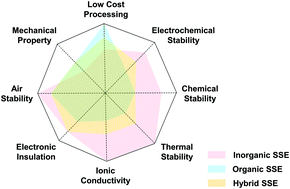Recent advances in the interface design of solid-state electrolytes for solid-state energy storage devices
Abstract
High-ionic-conductivity solid-state electrolytes (SSEs) have been extensively explored for electrochemical energy storage technologies because these materials can enhance the safety of solid-state energy storage devices (SSESDs) and increase the energy density of these devices. In this review, an overview of SSEs based on their classification, including inorganic ceramics, organic solid polymers, and organic/inorganic hybrid materials, is outlined. Related challenges, such as low ionic conductivity, high interfacial resistance between electrodes and SSEs, poor wettability, and low thermal stability, are discussed. In particular, recent advances in properties of SSEs and interface design of high-performance SSESDs are highlighted. Several interface designs, including hybrid, interlayer, solid–liquid, quasi-solid-state gel, and in situ solidification interface, between electrodes and SSEs for alleviating interfacial resistance, stability, and compatibility in SSESDs are comprehensively reviewed to provide insights into the future design directions of SSEs and SSESDs. The rational designs of various SSESDs for flexible and wearable devices, electronic devices, electric vehicles, and smart grid systems are proposed in accordance with different practical application requirements.

- This article is part of the themed collection: Recent Review Articles


 Please wait while we load your content...
Please wait while we load your content...